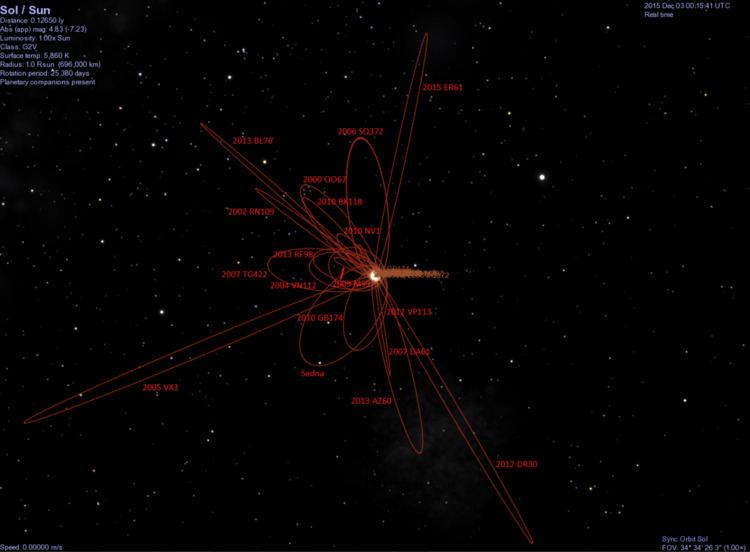Discovery date 2007-10-03 Minor planet category SDO | MPC designation 2007 TG422 Observation arc 2687 days (7.36 yr) | |
 | ||
Discovered by SDSS Collaboration
A. C. Becker,
A. W. Puckett,
J. Kubica
Apache Point (705) Aphelion 970 AU (Q)
(Heliocentric 950 ± 7 AU) | ||
2007 TG422, also written as 2007 TG422, is a scattered-disc object with a perihelion distance of 35.6 AU, which is just inside the gravitational influence of Neptune, and an aphelion distance similar to 90377 Sedna's.
Contents
Size
Mike Brown's website lists it as a possible dwarf planet with a diameter of 343 km based on an assumed albedo of 0.04. The albedo is expected to be low because the object has a blue (neutral) color. But if the albedo is higher the object could be much smaller. Assuming a generic trans-Neptunian albedo of 0.09, it is about 270 km in diameter. But because its true albedo is unknown and it has an absolute magnitude (H) of 6.2, it could be anywhere from about 150 to 340 km in diameter.
Orbit
2007 TG422 came to perihelion in 2005 at a heliocentric distance of 35.5 AU, and is currently 37.2 AU from the Sun. It will be in the constellation of Taurus until 2018. It comes to opposition 27 November 2016.
Given the orbital eccentricity of this object, different epochs can generate quite different heliocentric unperturbed two-body best-fit solutions to the aphelion (maximum distance from the Sun) of this object. With a 2007 epoch the object had an approximate period of about 10,611 years with aphelion at 930 AU. But using a 2012 epoch shows a period of about 13,512 years with aphelion at 1099 AU. For objects at such high eccentricity, the Sun's barycentric coordinates are more stable than heliocentric coordinates. Using JPL Horizons with an observed orbital arc of 5 years, the barycentric orbital elements for epoch 2008-May-14 generate a semi-major axis of 503 AU and a period of 11,300 years. For comparison, probable dwarf planet Sedna has a barycentric semi-major axis of 506 AU and a period of 11,400 years. Both (308933) 2006 SQ372 and (87269) 2000 OO67 take longer than Sedna and 2007 TG422 to orbit the Sun using barycentric coordinates.
2007 TG422 has been observed 98 times over seven years and has an uncertainty parameter of 2. It has not been observed since 2015.
